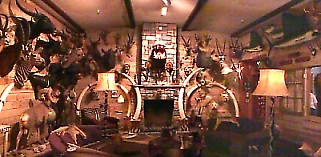 The Wilbur D. May Museum is a
10,000-sq. ft. ranch-style building designed to resemble his
residence. Four rooms are a re-creation of Wilbur's 2600-acre
Double Diamond Ranch, named for the brand that was created from
stacking his W and M initials. The living room chronicles his
life as a businessman, composer, pilot and philanthropist. This
room displays old pictures of his flying days when he was
considered one of the best navigators flying at the time. This
was long before the advance of such navigable delights as
satellite guidance and global positioning systems. There are many
of his paintings on display as well as a manuscript of one of the
songs he composed. The tack room showcases Wilbur's life as a
rancher.
The Wilbur D. May Museum is a
10,000-sq. ft. ranch-style building designed to resemble his
residence. Four rooms are a re-creation of Wilbur's 2600-acre
Double Diamond Ranch, named for the brand that was created from
stacking his W and M initials. The living room chronicles his
life as a businessman, composer, pilot and philanthropist. This
room displays old pictures of his flying days when he was
considered one of the best navigators flying at the time. This
was long before the advance of such navigable delights as
satellite guidance and global positioning systems. There are many
of his paintings on display as well as a manuscript of one of the
songs he composed. The tack room showcases Wilbur's life as a
rancher.  The trophy room
provides a glimpse of his big game hunting years of the 1920s,
'30s and '40s. This is a unique and exciting room which was
typically displayed in many large homes of the twenties. This
collection represents the trophy room at the Wilbur May’s
Double Diamond Ranch. Most of the animals displayed here and many
of the artifacts in the African gallery
The trophy room
provides a glimpse of his big game hunting years of the 1920s,
'30s and '40s. This is a unique and exciting room which was
typically displayed in many large homes of the twenties. This
collection represents the trophy room at the Wilbur May’s
Double Diamond Ranch. Most of the animals displayed here and many
of the artifacts in the African gallery were
collected in 1929 on Wilbur’s first safari. It was a time
when the only way that one could see these exotic animals was to
visit one at the few large cities that had a natural history
museum or zoo. It was common for Wilbur to shoot animals in pairs
so that he could make a petting pelt to allow visitors to feel
the animal's coat while viewing it. This also was an era when
hunting was a popular sport and collecting unusual animals was
quite a novelty. Hunters on safari in Africa were welcomed by
local peoples because the trophies that they collected provided
food for hundreds of people. The museum gallery is a compilation
of his more then 40 trips around the world. It holds a treasure
of priceless antiques and collectibles. You'll find a very rare
were
collected in 1929 on Wilbur’s first safari. It was a time
when the only way that one could see these exotic animals was to
visit one at the few large cities that had a natural history
museum or zoo. It was common for Wilbur to shoot animals in pairs
so that he could make a petting pelt to allow visitors to feel
the animal's coat while viewing it. This also was an era when
hunting was a popular sport and collecting unusual animals was
quite a novelty. Hunters on safari in Africa were welcomed by
local peoples because the trophies that they collected provided
food for hundreds of people. The museum gallery is a compilation
of his more then 40 trips around the world. It holds a treasure
of priceless antiques and collectibles. You'll find a very rare  collection of T'ang Dynasty
pottery (618-906 AD). There's a genuine shrunken head from South
America as well as primitive African artwork, Eskimo scrimshaws,
Egyptian scarabs and Greek icons. The Italian amulets found here
pre-date Christ's birth. At one point a branch is seemingly
coming out of the wall and a large cat crouches on it appearing
to protect its recent kill. Wilber was known as a savvy trader
and it was reported that he could talk the loin cloths of the
tribal elders.
collection of T'ang Dynasty
pottery (618-906 AD). There's a genuine shrunken head from South
America as well as primitive African artwork, Eskimo scrimshaws,
Egyptian scarabs and Greek icons. The Italian amulets found here
pre-date Christ's birth. At one point a branch is seemingly
coming out of the wall and a large cat crouches on it appearing
to protect its recent kill. Wilber was known as a savvy trader
and it was reported that he could talk the loin cloths of the
tribal elders.
***THE END***

